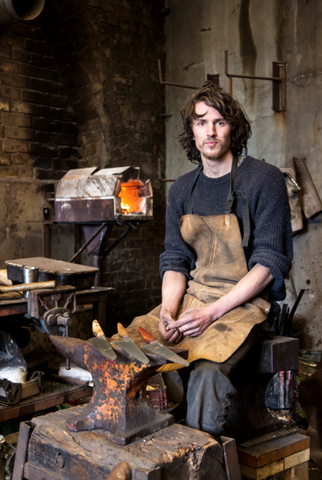Blades of Glory...
May 25 2016 0 Comments
It all started soon after the founders of London’s Blenheim Forge Jon Warshawsky, James Ross-Harris and Richard Warner wanted to create Japanese style kitchen knives using traditional Japanese metalworking.
But they didn’t travel to Japan, join a guild, or seek craftsman’s guidance. They just went to YouTube!

Formed in 2012 after making their first knife, consulting a YouTube tutorial and using a makeshift furnace, the trio now spend their days hammering out hand-forged kitchen knives - without ever having enrolled in a steelmaking class.
http://www.blenheimforge.co.uk/workshop/2016/5/12/blenheim-forge
The founders of Blenheim Forge made their first kitchen knife in the back garden of their Peckham home. It took two years of trying and failing to make a knife as good as the one they made for fun. Most of the Hardwood used to make the handles comes from gardens, customers or the nearby cemetery!!!
http://www.blenheimforge.co.uk/workshop/2014/12/10/blenheim-forge
And if you need some more inspiration, the following interview with James-Ross Harris was taken from an article posted by Arts & Entertainment and could give you some encouragement;
Quit your job become a … bladesmith
Knife forging: how do you make the cut?
‘I’ve always worked with metal. For a while I made bespoke furniture; then later, when I moved to London, I worked as a blacksmith for three years. During the weekends my business partner Jon and I used to mess around making knives. That led to us buying more and more tools. Before we knew it, we’d started a business.’
What’s your average day like?
‘It takes a lot to get a knife perfect – the quality of the steel, the blade, the balance. So I spend most of the morning hammering away in front of the fire. The afternoon is for grinding and polishing and handle-making. There’s a lot of rubbing!’
Sounds like a great night in. So who do you sell to? No one crazy, I hope.
‘A mixture of foodies and chefs. Some chefs are building up collections with us, and they’ll come back every couple of months to order a new one. We’ve actually got two chefs in there now, chopping up a load of potatoes, giving us some feedback.’
What’s the best part of the job?
‘The fact it’s my company; you’re just so much more involved. Plus, I love the feeling of finishing a knife – some of them can take up to 40 hours of work, depending on the blade. I also love getting feedback from a customer after they’ve used one of our knives for a couple of months.’
I suppose it’s not the best place to receive or give bad feedback – a room full of knives.
‘Yep, you wouldn’t want to say the wrong thing to a client in our workshop!’
So what’s the worst part?
‘The dirt. You get pretty filthy. We burn a lot of coke – it’s good for the steel. Also it took us ages to make Damascus steel, which is the process of folding two steels together to create a blade with hundreds of layers. I think we destroyed more than 300 knives in the end. That was pretty frustrating. But it’s a difficult process – kind of similar to making a samurai sword.’
And what is the market like for samurai swords?
‘I think swords are a bit nerdy really. Plus I don’t want to be selling swords to people!’
Interview by Michael Curle

Now... a question for our very active, passionate and responsive readers:
Have you taught yourself any skilled crafts using YouTube or any other video tutorial from the Internet? If you did, please share with us and leave us a comment.
Cheers, Gaston
0 comments

Leave a Comment